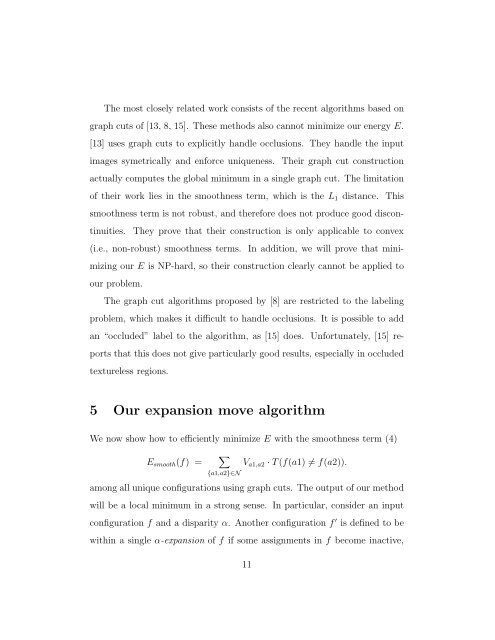Computing Visual Correspondence with Occlusions via Graph Cuts
Computing Visual Correspondence with Occlusions via Graph Cuts
Computing Visual Correspondence with Occlusions via Graph Cuts
Create successful ePaper yourself
Turn your PDF publications into a flip-book with our unique Google optimized e-Paper software.
The most closely related work consists of the recent algorithms based on<br />
graph cuts of [13, 8, 15]. These methods also cannot minimize our energy E.<br />
[13] uses graph cuts to explicitly handle occlusions. They handle the input<br />
images symetrically and enforce uniqueness. Their graph cut construction<br />
actually computes the global minimum in a single graph cut. The limitation<br />
of their work lies in the smoothness term, which is the L1 distance. This<br />
smoothness term is not robust, and therefore does not produce good discon-<br />
tinuities. They prove that their construction is only applicable to convex<br />
(i.e., non-robust) smoothness terms. In addition, we will prove that mini-<br />
mizing our E is NP-hard, so their construction clearly cannot be applied to<br />
our problem.<br />
The graph cut algorithms proposed by [8] are restricted to the labeling<br />
problem, which makes it difficult to handle occlusions. It is possible to add<br />
an “occluded” label to the algorithm, as [15] does. Unfortunately, [15] re-<br />
ports that this does not give particularly good results, especially in occluded<br />
textureless regions.<br />
5 Our expansion move algorithm<br />
We now show how to efficiently minimize E <strong>with</strong> the smoothness term (4)<br />
Esmooth(f) =<br />
<br />
{a1,a2}∈N<br />
Va1,a2 · T (f(a1) = f(a2)).<br />
among all unique configurations using graph cuts. The output of our method<br />
will be a local minimum in a strong sense. In particular, consider an input<br />
configuration f and a disparity α. Another configuration f ′ is defined to be<br />
<strong>with</strong>in a single α-expansion of f if some assignments in f become inactive,<br />
11

















